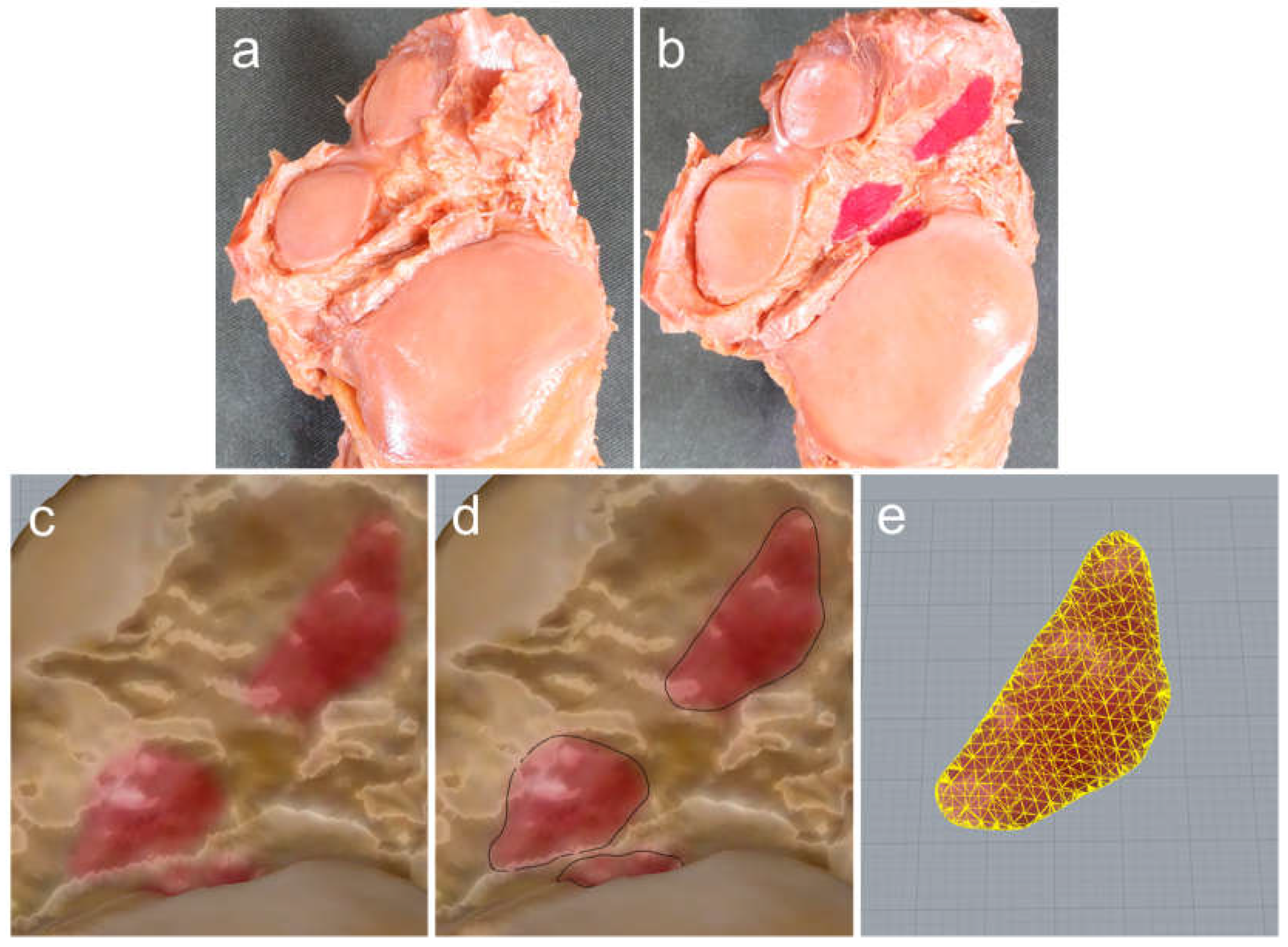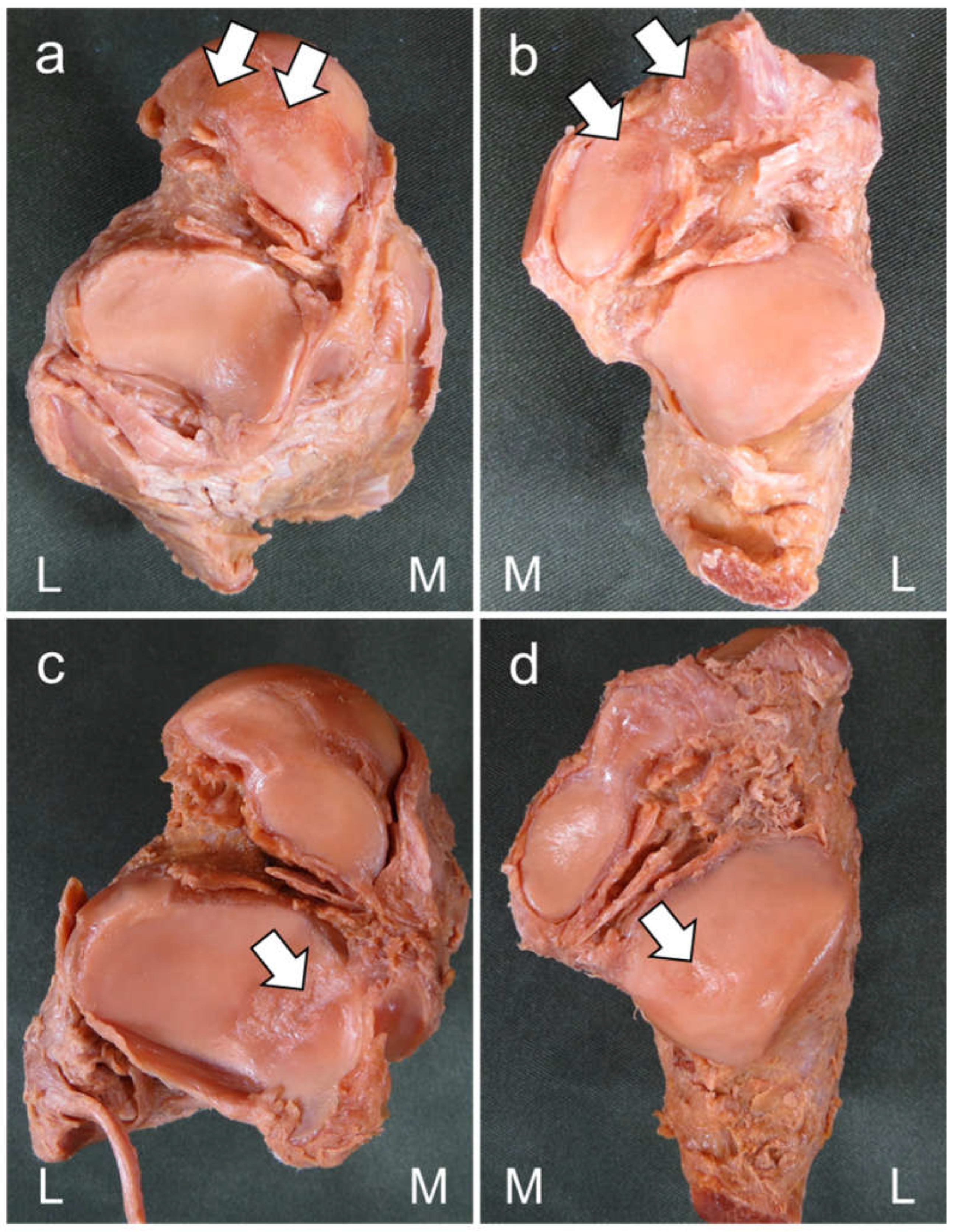Submitted:
07 January 2023
Posted:
09 January 2023
You are already at the latest version
Abstract
Keywords:
1. Introduction
2. Materials and Methods
2.1. Cadavers
2.2. Measurement procedures
2.3. Reliability of measurements of intersecting angle and footprint area
2.4. Statistical analysis
3. Results
3.1. Reliability of measurements of intersecting angle and footprint area
3.2. Joint and ligament structure and degeneration of the subtalar articular facet
3.3. Relationship between joint and ligament structures and degeneration of the subtalar articular facet
4. Discussion
5. Conclusions
Author Contributions
Funding
Institutional Review Board Statement
Informed Consent Statement
Data Availability Statement
Acknowledgments
Conflicts of Interest
References
- Michels, F.; Clockaerts, S.; Van Der Bauwhede, J.; Stockmans, F.; Matricali, G. Does subtalar instability really exist? A systematic review. Foot Ankle Surg 2020, 26, 119–127. [CrossRef]
- Pereira BS, Andrade R, Espregueira-Mendes J, Marano RPC, Oliva XM, Karlsson J: Current concepts on subtalar instability. Orthopaedic Journal of Sports Medicine, 9: 23259671211021352, 2021. [CrossRef]
- Aynardi M, Pedowitz DI, Raikin SM: Subtalar instability. Foot and Ankle Clinics, 20: 243-252, 2015. [CrossRef]
- Liu P, Chen K, Wang S, Hua C, Zhang H, Yu J: A mouse model of ankle-subtalar joint complex instability induced post-traumatic osteoarthritis. J Orthop Surg Res, 16: 541, 2021. [CrossRef]
- McKeon PO, Hertel J, Bramble D, Davis I: The foot core system: a new paradigm for understanding intrinsic foot muscle function. Br J Sports Med, 49: 290, 2015. [CrossRef]
- Budny A: Subtalar joint instability: current clinical concepts. Clinics in Podiatric Medicine and Surgery, 21: 449-460, 2004. [CrossRef]
- Stagni R, Leardini A, O'Connor JJ, Giannini S: Role of passive structures in the mobility and stability of the human subtalar joint: a literature review. Foot & Ankle International, 24: 402-409, 2003. [CrossRef]
- Drayer-Verhagen F: Arthritis of the subtalar joint associated with sustentaculum tali facet configuration. J Anat, 183 (Pt 3): 631-634, 1993.
- Madhavi C, Madhuri V, George VM, Antonisamy B: South Indian calcaneal talar facet configurations and osteoarthritic changes. Clin Anat, 21: 581-586, 2008. [CrossRef]
- Badalahu, Qin B, Luo J, Zeng Y, Fu S, Zhang L: Classification of the subtalar articular surface and its matching situation: an anatomical study on Chinese subtalar joint. Surg Radiol Anat, 42: 1133-1139, 2020. [CrossRef]
- Kleipool RP, Vuurberg G, Stufkens SAS, van der Merwe AE, Oostra R-J: Bilateral symmetry of the subtalar joint facets and the relationship between the morphology and osteoarthritic changes. Clinical Anatomy, 33: 997-1006, 2020. [CrossRef]
- Pellegrini MJ, Glisson RR, Wurm M, Ousema PH, Romash MM, Nunley JA, 2nd, Easley ME: Systematic quantification of stabilizing effects of subtalar joint soft-tissue constraints in a novel cadaveric model. J Bone Joint Surg Am, 98: 842-848, 2016. [CrossRef]
- Li L, Gollhofer A, Lohrer H, Dorn-Lange N, Bonsignore G, Gehring D: Function of ankle ligaments for subtalar and talocrural joint stability during an inversion movement – an in vitro study. Journal of Foot and Ankle Research, 12: 16, 2019. [CrossRef]
- Edama M, Takabayashi T, Inai T, Hirabayashi R, Ikezu M, Kaneko F, Matsuzawa K, Kageyama I: Morphological features of the cervical ligament. Surg Radiol Anat, 42: 215-218, 2020. [CrossRef]
- Michels F, Matricali G, Vereecke E, Dewilde M, Vanrietvelde F, Stockmans F: The intrinsic subtalar ligaments have a consistent presence, location and morphology. Foot Ankle Surg, 27: 101-109, 2021.
- Jotoku T, Kinoshita M, Okuda R, Abe M: Anatomy of ligamentous structures in the tarsal sinus and canal. Foot Ankle Int, 27: 533-538, 2006. [CrossRef]
- Li SY, Hou ZD, Zhang P, Li HL, Ding ZH, Liu YJ: Ligament structures in the tarsal sinus and canal. Foot Ankle Int, 34: 1729-1736, 2013. [CrossRef]
- Jung M-H, Choi BY, Lee JY, Han CS, Lee JS, Yang YC, Cho BP: Types of subtalar joint facets. Surgical and Radiologic Anatomy, 37: 629-638, 2015. [CrossRef]
- Bruckner J: Variations in the human subtalar joint. J Orthop Sports Phys Ther, 8: 489-494, 1987. [CrossRef]
- Nozaki S, Watanabe K, Katayose M: Three-dimensional morphometric analysis of the talus: implication for variations in kinematics of the subtalar joint. Surgical and Radiologic Anatomy, 39: 1097-1106, 2017. [CrossRef]
- Cho H-J, Kwak D-S, Kim I-B: Analysis of movement axes of the ankle and subtalar joints: Relationship with the articular surfaces of the talus. Proceedings of the Institution of Mechanical Engineers, Part H: Journal of Engineering in Medicine, 228: 1053-1058, 2014. [CrossRef]
- Hirose K, Murakami G, Kura H, Tokita F, Ishii S: Cartilage degeneration in talocrural and talocalcaneal joints from Japanese cadaveric donors. J Orthop Sci, 4: 273-285, 1999. [CrossRef]
- Kellgren JH, Lawrence JS: Radiological assessment of osteo-arthrosis. Ann Rheum Dis, 16: 494-502, 1957. [CrossRef]
- Landis JR, Koch GG: The measurement of observer agreement for categorical data. Biometrics, 33: 159-174, 1977. [CrossRef]
- Vina ER, Kwoh CK: Epidemiology of osteoarthritis: literature update. Curr Opin Rheumatol, 30: 160-167, 2018. [CrossRef]
- Tochigi Y, Amendola A, Rudert MJ, Baer TE, Brown TD, Hillis SL, Saltzman CL: The role of the interosseous talocalcaneal ligament in subtalar joint stability. Foot & Ankle International, 25: 588-596, 2004. [CrossRef]
- Tochigi Y, Takahashi K, Yamagata M, Tamaki T: Influence of the interosseous talocalcaneal ligament injury on stability of the ankle-subtalar joint complex — a cadaveric experimental study. Foot & Ankle International, 21: 486-491, 2000. [CrossRef]
- Liu K, Gustavsen G, Royer T, Wikstrom EA, Glutting J, Kaminski TW: Increased ligament thickness in previously sprained ankles as measured by musculoskeletal ultrasound. J Athl Train, 50: 193-198, 2015. [CrossRef]
- Stephens MM, Sammarco GJ: The stabilizing role of the lateral ligament complex around the ankle and subtalar joints. Foot Ankle, 13: 130-136, 1992. [CrossRef]
- Weindel S, Schmidt R, Rammelt S, Claes L, Campe Av, Rein S: Subtalar instability: a biomechanical cadaver study. Archives of Orthopaedic and Trauma Surgery, 130: 313-319, 2010. [CrossRef]
- Bunning PS, Barnett CH: A comparison of adult and foetal talocalcaneal articulations. J Anat, 99: 71-76, 1965.





| Degeneration | |||
| (+) | (-) | Total | |
| Number of joint facets (n) | |||
| Talar two-facet configuration | 17 | 21 | 38 |
| Talar three-facet configuration | 3 | 9 | 12 |
| Calcaneal two-facet configuration | 15 | 17 | 32 |
| Calcaneal three-facet configuration | 5 | 13 | 18 |
| Joint congruence (n) | |||
| Congruent | 18 | 26 | 44 |
| Incongruent | 2 | 4 | 6 |
| Intersecting angle (°) | 137.8 ± 6.7 | 138.7 ± 9.7 | 138.4 ± 8.6 |
- Congruent: Specimens with the same number of articular facets for both talus and calcaneus.
- Incongruent: Specimens with a different number of articular facets for the talus and calcaneus.
- Degeneration (+): Specimen with degeneration of the subtalar articular facet.
- Degeneration (-): Specimens without degeneration of the subtalar articular facet.
| Degeneration | |||
| (+) | (-) | Total | |
| Footprint area (mm2) | |||
| CL | 110.1 ± 46.0 | 113.6 ± 42.8 | 112.2 ± 43.6 |
| ITCL | 55.0 ± 21.1 | 44.1 ± 25.7 * | 48.4 ± 24.3 |
| ACaL | 44.9 ± 17.9 | 50.5 ± 29.1 | 48.3 ± 25.1 |
| Total footprint of CL, ITCL, ACaL | 210.0 ± 61.8 | 208.2 ± 74.2 | 208.9 ± 68.8 |
- Values are given as mean ± standard deviation. CL: cervical ligament; ITCL: interosseous talocalcaneal ligament; ACaL: anterior capsular ligament.
- Degeneration (+): Specimen with degeneration of the subtalar articular facet.
- Degeneration (-): Specimen without degeneration of the subtalar articular facet.
- *p = 0.036 vs. Degeneration (+) for the subtalar articular facet.
Disclaimer/Publisher’s Note: The statements, opinions and data contained in all publications are solely those of the individual author(s) and contributor(s) and not of MDPI and/or the editor(s). MDPI and/or the editor(s) disclaim responsibility for any injury to people or property resulting from any ideas, methods, instructions or products referred to in the content. |
© 2023 by the authors. Licensee MDPI, Basel, Switzerland. This article is an open access article distributed under the terms and conditions of the Creative Commons Attribution (CC BY) license (http://creativecommons.org/licenses/by/4.0/).





